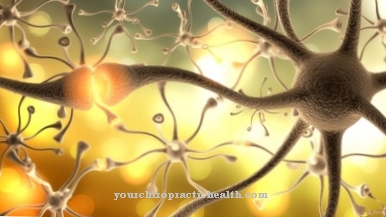The concept of Euthyroidism refers to the normal state of the pituitary-thyroid control circuit and thus assumes the adequate hormonal function of both organs. The control loop is also called a thyrotropic loop. In various thyroid, pituitary and hypothalamic diseases, it moves outside of euthyroidism.
What is euthyroidism?

The thyroid is a hormone-secreting organ. It works according to the so-called thyrotropic control loop, which is stretched between the thyroid gland and the pituitary gland. This regulatory mechanism controls the concentration of thyroid hormones in plasma. One of the most important thyroid hormones is thyroxine, which acts as a prohormone on receptors in the central nervous system.
The clinical term euthyroidism describes the normal state of a healthy thyroid gland and thus an undisturbed closure of the thyroid control loop when the thyroid gland is fully functional. Usually the term does not correspond to the expression 'healthy thyroid', but is used more in connection with goiter formation. In a euthyroid goiter, the thyroid gland is enlarged but functions normally.
Thyroid hormone treatment for hypothyroidism or similar diseases is also often referred to as euthyroidism as soon as the treatment produces normal thyroid values. Phenomena such as functional autonomy of the thyroid gland are rarely referred to as euthereosis, as the activities associated with it usually produce a needs-based hormonal balance.
Function & task
The thyroid gland is a hormonal gland and produces the hormones triiodothyronine, thyroxine and calcitonin. Historically, it comes from the epithelial tissue of the second gill arch. Anatomically it consists of two flaps that are connected by a narrow bridge. The thyroid lobes are about the size of an olive.
The main task of the organ is to produce the iodine-containing thyroid hormones, which are present in almost all cells of the body and which stimulate the energy metabolism. The production of these hormones is subject to a control loop by the hypothalamic hormone TRH. This hormone is also known as TSH-releasing hormone and regulates thyroid activity together with the thyroid-stimulating hormone of the pituitary gland.
This thyrotropic control loop has a precisely coordinated physiology. The pituitary gland secretes the control hormone thyrotropin to stimulate the thyroid gland to secrete thyroxine and triiodothyronine. This process is fed back.The thyroid hormones inhibit the secretion of TSH through a negative coupling in order to keep the level of all hormones involved in balance. The incre- ment of TSH is in turn dependent on the level of releasing hormone from the hypothalamus. This hormone of the hypothalamus provides the setpoint for the thyrotropic control loop.
In addition to this control loop, other feedback loops are involved in the regulation of the thyroid and pituitary activity. One of these is the TSH's ultrashort feedback mechanism. The distribution of TSH acts back on the own secretion within the framework of a Brokken-Wiersinga-Prummel control circuit. In addition to this principle, the long-feedback mechanism of the thyroid hormones for TRH secretion and thus ultimately also thyroid secretion plays a role. The same applies to the control circuits for the plasma protein binding of triiodothyronine and thyroxine.
The thyrotropic control loop can be in different states. If the condition is normal and the control loop is closed with a functioning thyroid gland, the doctor speaks of euthyroidism. Deviations from the normal euthyroid state of the control loop arise, for example, in the context of a thyrotoxic crisis, hypothyroidism and thyroid hormone resistance.
Illnesses & ailments
The term euthyroidism excludes a malfunction of the thyroid gland. However, the term does not necessarily exclude diseases of the thyroid gland. The printout only indicates the exclusion of symptoms that are noticeable in the thyrotropic control loop.
The thyrotropic control loop itself can get out of balance due to various diseases. Underactive thyroid is a possible cause. As part of this phenomenon, the thyroid gland only secretes a small amount of thyroid hormones. The cause of this phenomenon can lie in the thyroid gland itself or in organs that act on it, such as the hypothalamus.
Primary hypothyroidism also destroys the euthyroidism of the thyrotropic control circuit. Primary hypothyroidism occurs when the control loop in the thyroid gland has been broken. This can be the case, for example, in the context of a lack of incretion, as can occur postoperatively. Another cause of the phenomenon described are autoimmune thyroid disorders, in which the immune system is directed against the structures involved.
Secondary hypothyroidism may also move the thyrotropic control loop out of its normal state. With this phenomenon, the control loop is not interrupted in the thyroid gland but in the pituitary gland, as can be the case with HVL insufficiency. In tertiary hypothyroidism, on the other hand, euthyroidism is disturbed by a lack of target value due to a TSH deficiency. This condition occurs primarily with a lesion of the hypothalamus. All hypothyroidism is based on a specific deficiency.
This is to be distinguished from the pathological condition of hyperthyroidism, which is to be equated with an overactive thyroid and which also disrupts euthyroidism. Primary hyperthyroidism is caused by a pathological over-secretion of thyroid hormones as a result of a thyroid disease. The causative disease can, for example, correspond to autonomies or Graves' disease. Secondary hyperthyroidism, on the other hand, is caused by tumor diseases that are associated with TSH-producing pituitary tumors.
The thyrotropic control loop can also give way to thyrotoxicosis. In such cases, there is an oversupply of thyroid hormones, as can occur in the context of hyperthyroidism or various medication administration. A special case of thyrotropic imbalance is thyroid hormone resistance, in which the control loop between the pituitary gland and thyroid gland at the pituitary receptors is interrupted.




























